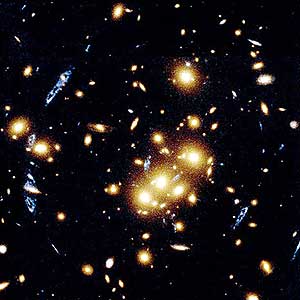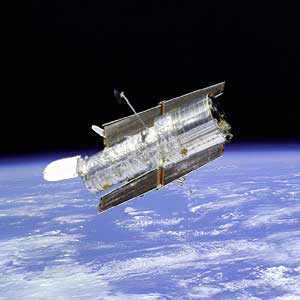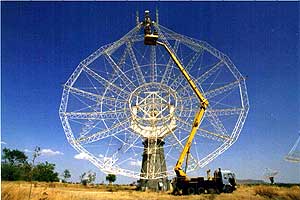 |
 |
 |
 |
Volume
5 - Issue 01 JANUARY 2007 |
|
|
MUSINGS from prasanthi nilayam IN QUEST OF INFINITY - PART ONE By Prof. G Venkataraman Getting Started Sai Ram and warm greetings. Starting with this issue, I would like to take you on an interesting journey in which we shall together SEARCH FOR INFINITY. The search for “Infinity” is nothing new, and has been going on for a long, long time. However, we shall do it in a different way, starting with the Universe we live in and examining what Modern Physics has to say about it. From there we shall travel still further, to things beyond, to the doorstep of True Infinity! From The Seen to the Unseen
Our tour is going to be long, and so that you have an idea of where we are headed, let me tell you that though we start with the Seen, later we shall wander into the mysterious realm of the Unseen! So be prepared for a dizzy tour! In our long tour, we shall encounter many things we barely understand, but of one thing you can be sure; wherever we turn, we cannot fail to see the glory and the majesty of God! Hence, even if there are things we do not quite understand, let us not be deterred by that; instead, let us, at every opportunity possible, simply drink in the glory of God and experience Ananda! All set to go? Have you fastened the seat belt? OK, we take off right now! StargazingLet us go out into the open and look above. It is a clear, cloudless and beautiful night and the sky is full of stars. We should be thankful that we are able to see the stars. In many places on earth, people can no longer see stars. You know why? Two reasons; one is too much pollution and second there is too much of man-made light that obscures the light from the stars. The sky is so beautiful, is it not? And we can see it for free, without buying any tickets or making any advance reservations! Yet, how many of us take time to do this? That is the tragedy of modern times! We all know the nursery rhyme that starts with the words: Twinkle, twinkle little star, We also delight in making our kids repeat this rhyme before visitors, in order to impress them. But do we wonder about these stars anymore? Let us spend time doing exactly that! Let us gaze deep into the sky. Do you know what we would see? I’ll tell you! We would see all sorts of things, and here is a brief description of the scale and size of things we would catch a glimpse of. Measuring Distance Using Light Years
A few words about the size of our Universe: It is huge, and I really mean huge. It is so huge, we need a measure of length much larger than the kilometre which is what we normally use for describing distances. It is ok to give the distance form Puttaparthi to New York in km, but when it comes to distances in the Universe, the km is too small. We shall instead use a measure called the light year [LY], which is the distance light travels in one year. You probably know that light travels [approximately] 300,000 km in one second, yes one second! Light takes about eight minutes to reach us after leaving the surface of the Sun. Obviously, a LY represents a much greater distance. In terms of numbers, it is 300,000 x 3,600 x 24 x 365 km; you can do the arithmetic! If you are too lazy to the arithmetic, let me tell you that one LY is roughly nine trillion km. If you think that is a lot of km, just wait; you are going to be stunned! Let us start with our own Solar system. The Sun, which is the focus of the solar system, is a star. As I told you, light from the Sun takes about eight minutes to reach the Earth. On the other hand, it you take planet Pluto, light from the Sun takes about five and a half hours to reach that planet. Like our Sun, there are at least a billion stars, yes, at least a billion, that form a part of our own galaxy known as the Milky Way. The diameter of the Milky Way is roughly 100,000 light years. That is big; yes it is, but, as they say: “You ain’t seen nothin’ yet!” Swami: Chancellor of our Galaxy and Beyond
Looking beyond the galaxy, there are the Local Groups [LG]. A Local Group may consist of about ten to fifty galaxies. The Milky Way belongs to a group of about twenty galaxies. The Andromeda galaxy, about which you must have surely heard, forms a member of the LG to which the Milky Way belongs. Based on the diameter of the Milky Way, we can say that typically, an average LG will have a size of about three million light years. We are now talking long distances, aren’t we? We move on and look at a bigger structure, the Galaxy Cluster. A typical cluster would have something like a thousand galaxies and a linear dimension of about fifteen million light years. Next comes the Supercluster, which is about ten times larger than a cluster, i.e., it has a linear extension of about one fifty million light years. Things sure are getting bigger and bigger, aren’t they? Structures of even larger scales are seen in the sky, and recently, astronomers have noted that something like filaments of bright objects exist. One of them has even been named the Great Wall! It is made up of several Superclusters.
What comes beyond? I am not too sure, but way beyond all this comes what we might call the edge of the Physical Universe! According to current estimates, what I refer to as the edge of the Universe is about fourteen billion LY away! What it means is that if light leaves the edge of the Universe right now, it would take fourteen billion years to reach the Earth (that is, if it is still there at that time!) Just for comparison, recall that light from our Sun takes about eight minutes to reach us. As we let all of this sink in, let us take a moment to do a bit of philosophical reflection. Swami is sometimes described not only as the Chancellor of the Sri Sathya Sai Institute of Higher Learning, but also as the Chancellor of the Universe. I wonder whether people who use this description have any idea of how big the Universe we are in actually is! Our Ego: An Insignificant Spec in the Cosmos
Swami comments on the fact that man is so insignificant and yet has aHimalayan ego. We might take a moment to reflect on that, too. The Physical Universe may be finite but it is vast nevertheless. In this vast Universe, there are billions and billions of galaxies, each galaxy having billions and billions of stars. Our Sun is one such star in one particular galaxy that we call the Milky Way. And in the planetary system that exists around the Sun, our Earth is one small planet. And in that planet there are so many countries. If we take all these factors into consideration, then each of us is one incredibly insignificant spec in Cosmos. And yet, how much ego we tend to have! Any time we tend to feel egoistic, it would do us some good to look at the starry sky and reflect on the enormity of the Universe in which we are embedded! What should be huge within us is not ego but Divine Love, which the merciful Lord has deposited in full measure! OK, let us get back on our tour. Did you realise that we are taking a peek into distant parts of the Universe, without even leaving planet Earth? How come I am able to talk so confidently about the various objects in the Universe? How do we know where and what exactly it is? Believe it or not, just by looking! Just by looking from the Earth? Am I serious? Yes, just by looking, and I am dead serious when I say that. Believe it or not, staying on the Earth and looking out all the time, man has discovered an incredible amount – that one fact alone ought to make clear the incredible power God has put into man, as opposed to the other living species. Understanding Our Place in the Universe
The question now arises: “How exactly does man go about ‘looking’ out into the sky as it is said?” In ancient times, man had only the eyes as God gave him. Even with this, he was able to do quite a lot. Thus, astronomers in ancient India, Greece, Egypt and China knew a lot about the constellations of stars and the way planets moved amongst them. They could predict eclipses, and a number of other rare planetary configurations. Basically, all such information related to stellar movements and groupings. It was very useful and gave us the first idea of the solar system. Incidentally, this also gave the first almanacs. The first quantum jump in this entire process of “looking” came with the invention of the optical telescope. Where astronomy was concerned, it was almost like the discovery of America. It is barely four centuries since the telescope was invented and what an extra-ordinary amount of information it has contributed! The moment man had the telescope, he could see so much more; not only that, he could see objects bigger and often more clearly – we have all wonderful pictures of the Moon complete with craters; that alone is sufficient to help us appreciate what a tremendous job the telescope has done. As years went by, the telescopes kept getting not only bigger but also better and better all the time. What is the meaning of getting better? Basically there are two things that determine the quality of a telescope – its light gathering power, and its resolution. The bigger the lens, the greater is its light-gathering power; and the greater the light-gathering power, the farther one can see with the telescope. Next, the better the design of the lens, the clearer the picture one gets with the telescope – this we know from our experience with cameras. These two parameters, size and quality are what have pushed up the costs of telescopes; but all that expenditure has been very worth while. Technology Helps Us See Further Faster
Today, technology has been pushed to the farthest limit and we may even say that further improvement for earth-based telescopes would entail enormous cost with very little return. What is it that sets this limit? The atmosphere! Atmosphere? Yes, atmosphere; we don’t realise that it is the atmosphere that makes the stars twinkle, as the nursery rhyme so beautifully describes. You see, atmospheric density is not constant, being disturbed by all kinds of factors related to weather, wind, dust. etc. The net result is that the light rays reaching us from distant stars wobble a bit [due to refraction], giving the impression of twinkling. While the twinkling phenomenon is very nice for poets, for astronomers it is a terrible headache, especially when they want to photograph weak stars. How to get rid of this botheration with twinkling? One way is to put the telescope in space, and that is how the idea for the Hubble telescope was born. This telescope was launched by America and put in space by one of Space Shuttle flights. It is fully automated and controlled remotely from the ground. In space there is no atmosphere and so no nuisance due to twinkling and all that – the pictures are therefore much better. I am sure you have all heard of the Hubble telescope and the wonderful pictures it has provided to astronomers. Now even as the telescopes kept getting better all the time, astronomers discovered better ways of using them. In the good old days of Newton, one had to literally to sit up all night and peer through the telescope. If one was looking at a nearby object like say Mars, it would move relatively rapidly across the sky and so the old-time observer was obliged to keep turning the telescope to keep the object in sight. In due course, a gadget based on clockwork was invented that automatically turned the telescope. This was particularly useful where big telescopes where concerned. The next intelligent idea was to replace the eye with a camera. A telescope with automatic movement and a camera attached meant that the astronomer could set it all up and even go away to have his dinner or whatever. Meanwhile, the telescope would be “staring” at the star or galaxy and keep on collecting the light coming from it. In this way, the photographic plate in the camera could be exposed for several hours at a time. This meant that one could catch very faint stars and find out what they were doing. Fraunhofer LinesAnother very interesting trick that astronomers regularly employ is based on a finding by the German astronomer Fraunhofer way back in the early part of the nineteenth century. Fraunhofer directed his telescope to the Sun and found that when he introduced a prism, then not only was the sunlight split into seven colours but also that the multi-coloured spectrum had dark lines. These lines are now called Fraunhofer lines. No one knew at that time what they meant. Today we know why there are such lines. These dark lines are the “bar codes” of atoms in the Sun, as one scientist graphically describes them.
Fraunhofer lines tell us many things about the celestial object studied. In the case of the Sun, they have revealed an enormous amount – the types of chemical elements present in the Sun and the surface temperature, for example. Indeed, the study of spectral lines has been pushed to a very fine art and today, astronomers can examine spectral lines associated with light coming from the most distant objects in space called quasars (short for Quasi-stellar objects), which are almost at the edge of the Universe.
And where distant objects are concerned, spectral lines also tell us about how fast the concerned object is moving! In fact, it is from a careful study of this nature that astronomer Edwin Hubble was able to establish that our Universe is actually expanding. That story later. The optical telescope has been the workhorse of astronomers for centuries, and with fancy attachments like the CCD camera, it is continuing to do wonders. But a telescope no longer means just tubes and lenses or mirrors made of glass. Today there are all kinds of telescopes like the radio telescope, the microwave telescope, the infrared telescope, the x-ray telescope and the gamma-ray telescope. And in the not too distant future we might even have neutrino telescopes and gravity telescopes – the progress made in the second half of the twentieth century is simply unbelievable! Visible and Non-Visible Light RadiationWell, what do all these mean? To understand this in a simple manner, we start with sunlight. As all school-children know, when sunlight is passed through a glass prism it splits into the familiar seven rainbow colours. We describe this by saying that the Sun emits light at several wavelengths ranging from the red at one end to the violet at the other. OK, this range represents a certain band of wavelengths from about say 6000 Å [Angstroms; one Angstrom is one tenth of a trillionth part of a metre!] to about say 3000 Å. Does the Sun emit radiation at other wavelengths also? If so, why can’t we see it? We seem to see only seven colours all the time.
This is an interesting point, and shows the way God “designs” systems! Actually, the Sun emits radiation at all wavelengths, but God in His Wisdom has considered it sufficient if our eyes are sensitive to that portion of the spectrum where the Sun’s light is brightest! Something similar happens in the case of sound also. All of us can hear sounds with frequencies only in a certain limited range. We cannot hear high frequency sound and likewise we cannot also hear sound of very low frequency. However, some animals can hear sound frequencies we cannot. God has designed the hearing system to suit the animal. Similarly, God has designed man’s sensory systems to aid his survival (in the external world that is!) Man is intended to be a day bird, and that is why his eyesight has been designed to suit daylight and the sensitivity of the human eye is limited to the spectral regions where Sun shines brightest. On the other hand, there are animals that move about mainly in the night, and their eye-sensitivity is quite different. Who can deny that God is Great! OK, what is the point of all this? Simply that objects in the Cosmos can emit radiation at many different wavelengths, which means that to study celestial objects we must really look at them at as many wavelengths as possible. Thus, while the early studies of our Sun were performed entirely on the basis of visible radiation, today astronomers study the Sun at all sorts of frequencies ranging from the infra-red to the x-ray region. This is possible on account of various developments in technology, thanks to which we now have all kinds of telescopes as I mentioned earlier. Such wide-spectrum and broad-band studies reveal a lot more. Some celestial objects do not emit visible radiation at all, in which case one has no choice but to resort to non-visible astronomy like radio astronomy, for example. The Places to Appreciate the Glory of God
Advances in technology have also altered the culture of astronomical research. For example, optical telescopes are best located at high altitudes so that the disturbance form the atmosphere is minimised. At the present time, two favourite locations are Hawaii, and the Andes mountains in Chile. Telescopes located here have been built at very great expense, and research time is allotted on the basis of scientific proposals submitted by various research groups. There is, near Bombay/Mumbai, a huge radio telescope known as the GMRT (Giant Metre Radio Telescope.)This telescope has an array of antennas that look like TV satellite dishes, only they are much larger. There are over thirty of these, spread across an area of about thirty sq. km. This telescope has been designed to receive radio waves of 1 metre wavelength – many celestial objects emit at this wavelength. Radio astronomers from all over the world bid for time, and observation time is allotted, based on selections made by an international peer group. Has all this been worth it? One would think so, judging by the amount of scientific information and knowledge that has been gained. One might ask, and this is often done: “Why spend so much money on all this when people are dying of starvation, hunger etc.?” This does seem like a pertinent question, but this must be considered against the proper perspective. If one examines the world budget on exploring the Cosmos, that would be peanuts compared to the money spent on violent and unproductive ventures like war, harmful ventures like spreading profanity, gambling, etc. It is therefore not correct to dismiss all scientific research in one breath. Knowledge of the Universe that the merciful Almighty created for us to live in should be welcomed. In fact, such knowledge, though it is only about the physical Universe, would still help in appreciating the Glory of God and the wonders He has packed into Creation. That is all for this instalment, and let me mention that we have barely started on our journey! There is so much more to come. Meanwhile, do spend a few moments looking up at the sky (if in your part of the world it is not covered with smoke and filled with man-made light.) There is God in all His Glory looking down, shining and smiling, and blessing us. Have His Darshan.
|
| You can write to us at : h2h@radiosai.org |
Vol 5 Issue 01 - JANUARY 2007
|
Best viewed in Internet Explorer - 1024 x 768 resolution. |
DHTML Menu by Milonic. |










